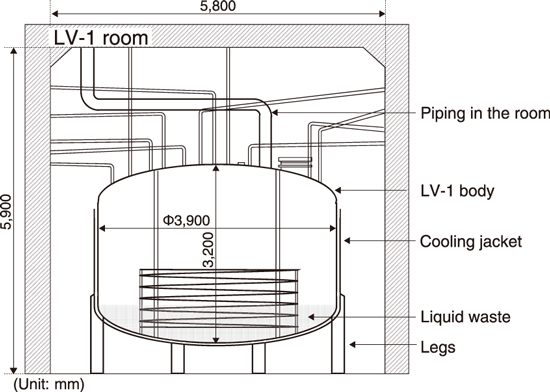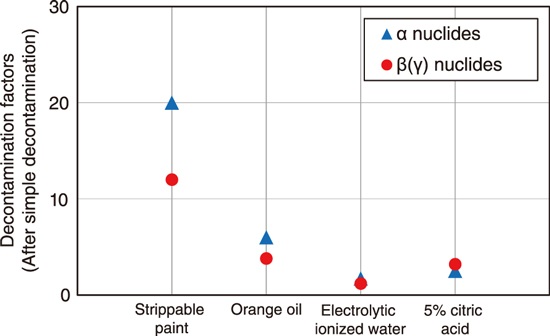
Fig.8-17 LV-1 layout sketch

Fig.8-18 Decontamination test result
Table 8-1 Comparison of cutting efficiency by the equipment

The JAERI’s Reprocessing Test Facility became the first facility in Japan to successfully recover plutonium from spent fuel through a reprocessing test (PUREX method) in 1968. Since 1996, it has been dismantled, and its work data on work management, radiation control, waste management, etc. have been obtained for future efficient decommissioning work plan. Herein, we describe the findings obtained from the dismantling of a large tank (hereinafter, referred to as “LV-1”) (Fig.8-17) that stored liquid waste containing fission products, including α nuclides.
Decontamination before dismantling is very important for reducing worker exposure. To select an efficient decontamination method, we conducted a decontamination test at the inner bottom of LV-1 (material: SS304L). First, simple decontamination was performed by wiping with wet rags. Then, the bottom of LV-1 was divided into four sections that were decontaminated using one of the following four materials: 5% citric acid, electrolytic ionized water, orange oil, and strippable paint. Fig.8-18 shows the decontamination factors (the radioactivity surface density before decontamination divided by that after decontamination), which indicate that strippable paint is effective for storage tanks with large amounts of a nuclides such as LV-1. These data are very useful for dismantling similar facilities.
To prevent an increase in the airborne radioactivity concentration as the main body of LV-1 is cut with a disk-saw, the contamination inside LV-1 was fixed with paint before cutting, and we used a full-face mask instead of a ventilated suit. From Table 8-1, the average cutting length per person per day when using the ventilated suit is more than 1.8 times that when using only the full-face mask. The total manpower for the cutting operation with the full-face mask, including decontamination and painting, was 743 labor-days. On the other hand, the estimated labor for the cutting operation was 912 labor-days without decontamination, without painting, and with the ventilated suit. Therefore, decontamination and painting are effective in reducing worker exposure and manpower.
From the dismantling of LV-1, we obtained very important work data for decommissioning. We will accumulate the work data, which can make future decommissioning more efficient.
(Yuta Yokozuka)